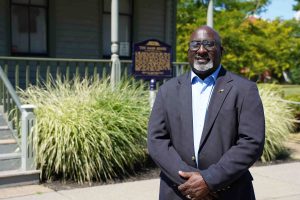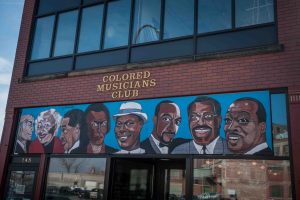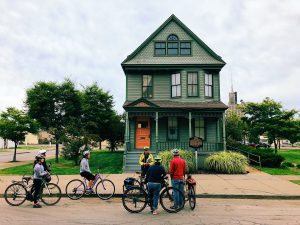A New Vision for Michigan Street
Terry Alford is the new Executive Director of the Michigan Street African American Heritage Corridor Commission. His previous experience includes positions with Roswell Park’s Office of Cancer Health Disparities Research and the Erie Niagara Tobacco-Free Coalition at Roswell Park. He holds a Master of Arts in Organizational Leadership from Medaille College and a Bachelor of Arts in Sociology, with a minor concentration in Urban Planning from the State University College at Buffalo.
A native of Buffalo, he grew up in neighborhoods near the Michigan Avenue corridor. He lives in East Buffalo with his wife, Laurie, a nurse practitioner with Neighborhood Health Center.
This interview was conducted via email and has been edited for length.

Visit Buffalo Niagara: What is the status of a new Visitor Center in the Michigan Street Corridor?
Terry Alford: The vacant, city-owned building at 509 Michigan Avenue, south of the historic Michigan Avenue Baptist Church, is in line for a restoration and expansion. Carmina Wood Morris has prepared plans for the stabilization and construction project pro-bono. This 1500 sq. ft. building will be restored. An addition will be added to the south of the building (subsequently becoming 507 Michigan Ave.) which recreates the original facade and the two main wings of the building will be connected at the rear portion and separated by a courtyard at the front, closest to Michigan Avenue. (We) are discussing these plans with the City to confirm if a visitors’ center will be included in the initial renovations. No timelines for construction have yet been confirmed.
VBN: What plans are underway to take the Corridor to the next level as an attraction and civic amenity?
TA: The most substantial plan the Commission is moving ahead with right now is identifying an agency that will assist us in developing a comprehensive Master Strategic Action Plan. The overall goal is to use this planning effort to develop a uniformly agreed-upon vision for telling the important stories of the Corridor, achieving sustainable operations of the MSAAHCC, and further developing our assets (as well as creating more assets) to facilitate increased visitors and additional future private investment along the entire Corridor.

VBN: Is there anything holding the Corridor back from greater visibility and success?
TA: No. I believe the only real barrier for this Commission and its stakeholders has been a lack of a strategic action plan that clearly has a set of goals and objectives, with clear timelines for getting items completed. The passion and commitment have always been there. Our cultural anchors have been working harmoniously and making those tough decisions that in the end only builds greater trust amongst them. The Commission has dedicated and supportive funders who all want to see the Corridor become the success we all know it can be.
VBN: Does the Black Lives Matter movement and its impact on social justice and awareness of inequality present an opportunity for the Corridor to play a greater role in addressing these issues in Buffalo?
TA: Yes, absolutely! Our Corridor revival efforts come at a time when nationwide protests over police brutality and systemic racism have sparked interest in our Corridor. The social consciousness has spurred a great deal of interest in history in general, African American heritage specifically. As you know, at one time the early-20th Century Michigan Street birthed the likes of the Rev. Edward Nash and Mary Talbert, early champions of what we now know as social justice.
The synergy created as a result of current events has prompted us to begin conversations with similar organizations in Niagara Falls, Rochester, and even Canada on how to create a regional hub of African American history and heritage to effectively broaden those stories on the struggle for freedom.

VBN: Are there plans for more murals celebrating the Black experience in Buffalo?
TA: Yes! We will be reaching out to organizations like the WNY Urban Arts Collective to begin those conversations. We want to ensure that local artists of color have fair and equitable, non-exploitive opportunities to participate in all public arts projects sponsored by our organization.
VBN: How can our cultural anchors better coordinate their efforts to attract visitors?
TA: The Commission will have to create a “cool” marketing campaign that could be promoted across the nation that would trumpet Buffalo and the WNY-region as a pre-eminent leader in African American heritage and history. Obviously, smart use of new technologies and on-demand platforms (not just traditional websites and social media platforms), including apps, will be key to effectively compete for tourists in this field.
VBN: Where do you see the Corridor in the next five years?
TA: My vision is to see our Corridor become ranked as one of the top ten successful heritage tourism sites in the nation. I would like to see the entire 3.5 miles of the Corridor become a “walking museum”, popping with color and the sweet scent of gardens, that will promote music, the arts, and our rich history in our city. I envision a vibrant mixed-used community where people can work, play, and live, generation-to-generation.
